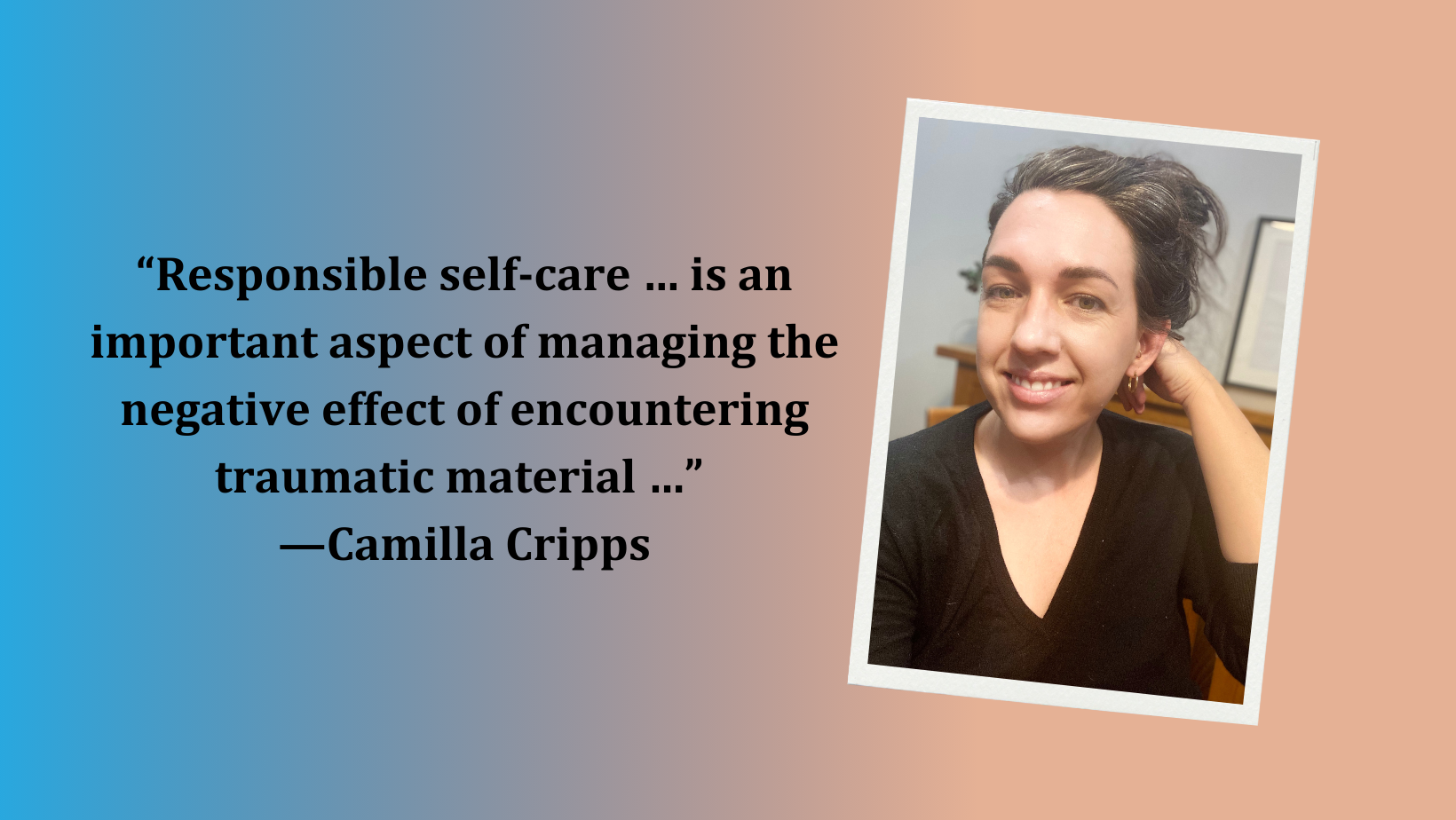By Kerry Anderson
Sometimes editors are confronted with harrowing material in an author’s manuscript and, as we read, we empathise with the experiences of the author – including their pain and their trauma. Sometimes authors tell us directly about their experiences, and sometimes we are thrown back into our own past traumatic memories.
This was the theme of Camilla Cripps’ presentation, “Pervasive and problematic: editing trauma in the Australian context”, hosted on 4 June 2024 by Editors NSW.
Camilla’s research looks at the intersection of trauma and creative praxis, and over an hour that seemed to fly by, she offered us a comprehensive and compassionate analysis of trauma. She outlined how an author’s words can strike that emotional chord in an editor; how we can conduct our work sensitively around clients who have endured distress and trauma; and the care and consideration we need to give ourselves as we work with potentially problematic texts or clients.
What is trauma?
The three main descriptors of personal trauma can be listed as acute, chronic and complex. Acute trauma can result from one single major incident. Chronic trauma results from a series of related traumatic events. Complex trauma occurs when a person is retraumatised either internally (as in emotional harm; for example, by neglect or abuse) or externally (for example, physical abuse). This put me in mind of a road that floods in the same place every time it rains and how, over time, the surface gives way to ever-widening potholes.
The younger the person is when the trauma occurs, the more this stress will affect the amygdala – that part of the brain that senses danger and reacts by activating our fight or flight system, and the hippocampus – the part where memories are stored. Trauma survivors often lose the ability to categorise and order their memories.
Camilla compared the categorisation of memories to a precariously packed warehouse, and a traumatic experience to a poorly driven forklift. Instead of being stored neatly on the correct shelf, boxes containing the memories of survivors are easily knocked over and strewn about the floor. This memory disorganisation is deleterious to a person’s cognitive function – it is much easier to deal with daily life if one’s memories are stored on their proper shelves.
Trauma crosses cultural boundaries, affects multiple generations of families. In fact, whole communities may be dissolved as their social bonds are fractured by collective experiences of trauma such as war or natural disaster.
Socially generated collective trauma can include historical, intergenerational and structural trauma.
Historical trauma, emanating from persecution, displacement and multigenerational identity loss, results in a proven decrease in wellbeing, mental and physical health, and housing and employment security.
Intergenerational trauma is a cycle of trauma handed down from one generation to the next and perpetuated by maladaptive coping mechanisms and behavioural patterns in the primary victim, such as substance abuse, resorting to violence during conflict, and poor mental health. This may be envisioned as a “tree of trauma” sprouting from a primary trauma seed and spreading up and across the generations of a family.
Structural trauma refers to how the structural designs of societies work against vulnerable, often minority, populations, generating and reinforcing inequalities. These normalised cultural designs often limit access to opportunities, healthcare, education and employment. They are ingrained in policies, laws, institutions, and even in those community organisations designed to help those individuals.

Editing and trauma
As editors, working on manuscripts that include representations of neglect, sexual abuse, violence, loss of home, family or identity, we are compelled to create a culture of safety for our clients, and especially for ourselves. The adverse consequences of secondary trauma experience, such as vicarious trauma, compassion fatigue and burnout, are real and significant risks to an editor’s wellbeing – something to be aware of during the editing process. Editing a painful memoir, for example, has the potential to result in an editor’s own retraumatisation and may eventually reduce one’s ability to work well.
“… if we can equip … editors with reading resilience skills and knowledge of how to successfully implement self-care strategies …” [Cripps 2022]
From the beginning of the editing process: clearly outline the roles of author and editor; establish boundaries that protect your wellbeing; be transparent in the objectives.
“Responsible self-care … is an important aspect of managing the negative effect of encountering traumatic material …” [Cripps 2022]
For the client, there also exists the real possibility that they will be retraumatised by confronting memories in the process of writing or redrafting their manuscript. Check in with clients (via Zoom is good) as they work through their drafts. If you feel it necessary, refer them to your state’s public mental health service – for New South Wales residents, this is the Mental Health Line (1800 011 511) – which will act as an effective triage for someone needing clinical assistance or pastoral mental health support.
Thank you, Camilla, for sharing your research with us and for your sensitive insight into an important subject.
Contact details of organisations offering support can be found at:
- https://www.mentalhealthcommission.gov.au/find-support
- https://info.health.nz/mental-health/mental-health-services/where-to-get-help/
A recording of this presentation is available to purchase and view until Monday 16 September 2024.

